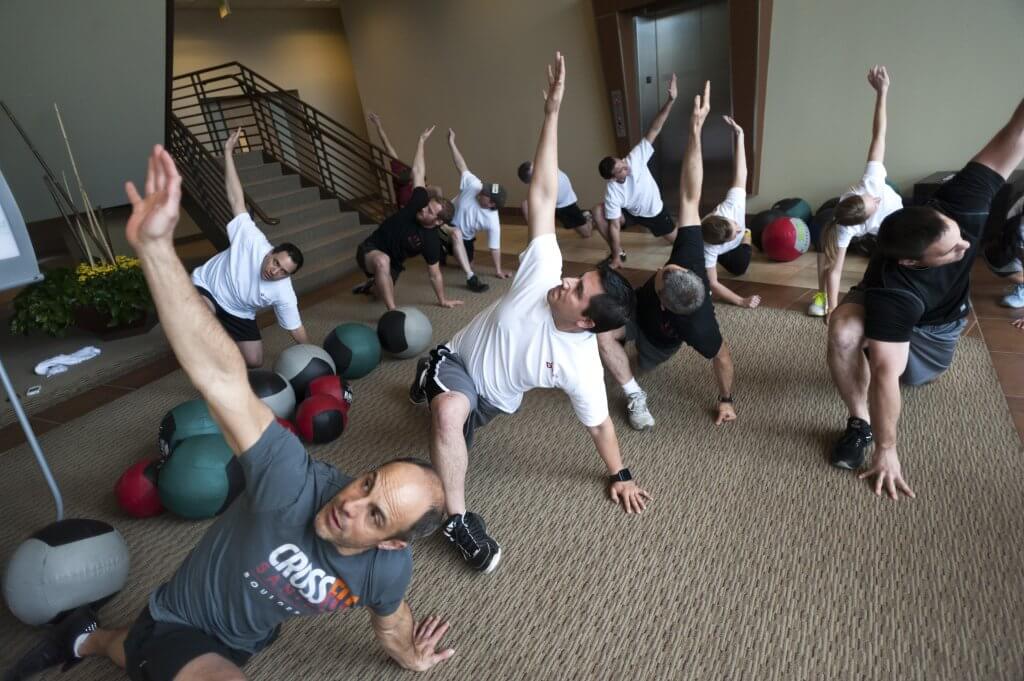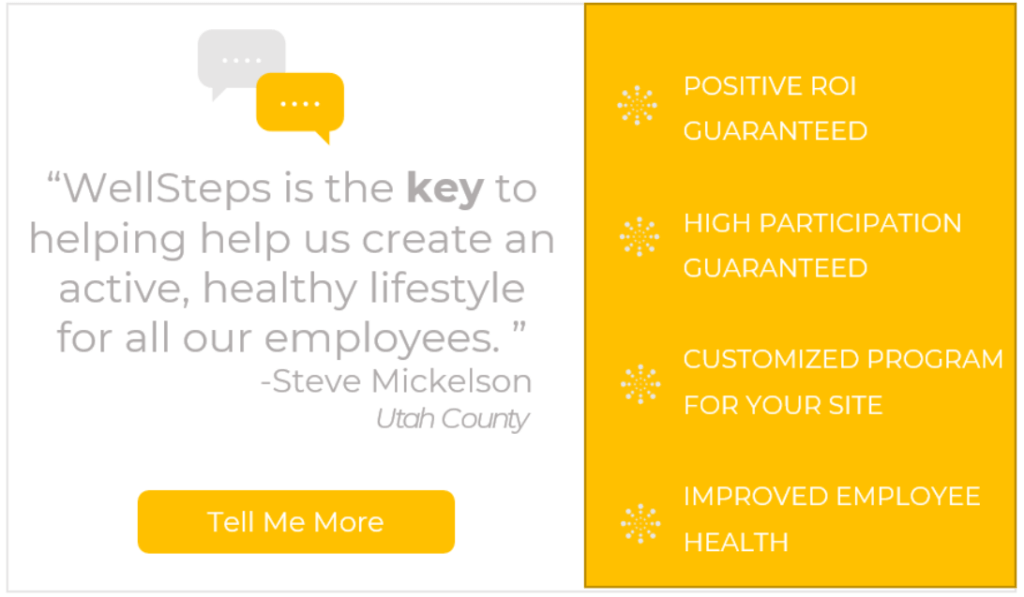The decision to start a wellness program for employees requires a substantial commitment of both time and resources. Programs that are started for the right reasons can transform the worksite culture and the very lives of employees and their families.

There are a few factors that can predict which programs will thrive and which ones were will fail. Here is a list of health and wellness questions that can be used to help companies make the right choice on whether or not to start a wellness program.
1. Why do you want to start a wellness program?
We ask this question with every client that is considering WellSteps as their wellness vendor. About 85% of the time employers say that the reason they are wanting to do wellness is to improve the health of their employees and to reduce employee-related expenses.
The other 15% of the time employers want to do wellness because they feel it is the right thing to do for their employees. They want their worksite to be an enjoyable and rewarding place to work where the employees are healthy, happy, and productive.
Both of these are valid reasons to do wellness, but they will require a different type of wellness program. If the goal is to improve employee health and reduce employee related expenses, then the program must be focused on helping employees adopt and maintain healthy behaviors. These types of programs require a comprehensive approach to helping employees have healthy lifestyles.
If the goal is to improve employee health and reduce employee related expenses, then the program must be focused on helping employees adopt and maintain healthy behaviors.
If the goal is just to foster a an enjoyable and rewarding work environment then the wellness program may not need to be so focused on behavior. It could be focused more on having fun.
RELATED: 13 Fun Workplace Wellness Challenge Ideas Your Employees Will Enjoy
2. How will you know if your wellness efforts are successful?
Here are some important health and wellness questions to ask:
- If you start a wellness program today, how would your worksite be different three years from now?
- What would success look like?
- How do you plan to quantify that success?
- What measures will you use?
Before you start a wellness program, sit down with your management team and answer these questions. If you’re having a hard time answering them perhaps your organization is not ready to start a wellness program.
If you can answer them, use your answers to help you select a wellness vendor that can provide you data on how your program is improving employee health behaviors, lowering health risks, and reducing employee related expenses. Remember, to successfully measure the impact of your wellness program you need to gather the right data at the beginning and across time.

The WellSteps performance guarantee is used by many organizations as a measure of program success. They refer to it before they begin a wellness program.
Year 1. At the end of year one, program participation will exceed 50% of all eligible participants.
Year 2. At the end of year two, program participants will demonstrate a minimum improvement in health behaviors or health risks of no less than 7% For example, at the end of year two, program participants will be 7% more physically active than when they started the program.
Year 3. At the end of year three, program participants will have fewer medical expenditures than non-participants. The savings will total at least 150% of the cost to deliver the program.
RELATED: How to Design Wellness Programs That Are Successful
3. What is the nature of your workforce?
A wellness program for the employees of a single location will look and feel very different from wellness program for employees spread out over multiple locations, time zones, and languages. Geographic location is just one thing to consider when starting wellness program.
The type of work you perform is also important to consider. Retail establishments, for example, can sometimes have very high rates of employee turnover.
It doesn’t make much sense to spend time and money on a wellness program for employees who will not be working there in six months. These same retail establishments also have employees who are in management positions where the turnover rate is much lower.
Rather than offer a full wellness program to your high turnover employees, some worksites will offer a reduced version of wellness to them while offering a comprehensive solution to their full time, benefited employees.
The same thing is true for worksites that have seasonal or temporary workers. In general, wellness programs are easier to start and administer when you have employees who are already receiving other workplace benefits.
RELATED: How Wellness Programs Increase Employee Retention in the Workplace
4. Who will be offered your program?
Do you want to provide your wellness program for all employees or just those who are benefited? What about spouses/significant others and dependents?
If you are providing health insurance for your employees, you are paying for the medical expenses of dependents as well. If the goal of your wellness program is to reduce healthcare expenditures than it only makes sense that you extend some or all of your wellness offerings to your employees’ significant others. After all, you are paying for their health, why not help them avoid chronic diseases?

To successfully get individuals to adopt and maintain healthy behaviors it is important to have support from others. For this reason alone, our WellSteps wellness solutions are made available to spouses at no additional cost. Successful behavior change requires support from others.
RELATED: WellSteps Wellness Solutions
5. Do you have strong leadership support to start a wellness program?
This is perhaps one of the most important questions to ask. Many worksites initiate a wellness program with limited leadership support. This is not necessarily a bad thing, but it is a limitation on the effectiveness that the program will have.
Those worksites that have strong leadership support also have a functioning, effective wellness committees that help guide and direct the wellness program. The wellness committees give ownership of the program to the employees themselves. When you have a wellness committee your employees feel like the program is theirs and not something that management is trying to do to them.
When you have a wellness committee your employees feel like the program is theirs and not something that management is trying to do to them.
Companies with strong leadership support have leaders who participate in the program in very visible ways, such as:
- they participate in campaigns
- they participate in team challenges
- they talk about the wellness program
- they are involved in the evaluation and reports of the program
- they personally believe in the benefits of having a healthy lifestyle
Even if a worksite doesn’t have strong leadership support in the beginning there are steps you can take to improve leadership support.
Every employee benefit was started by company leadership at some point. The decision to start employee benefit is a big one because employee benefits are easy to provide but difficult, if not impossible, to remove.
Strong leadership support is always necessary before offering an employee benefit. If you are going to start a wellness program you need to be committed to a long-term approach to improving employee health. Treat the decision just like you would any other benefits offering.
RELATED: How to Get Leadership Support for Employee Wellness
6. Do you want to go it alone or use professionals?
Senior leaders can also decide whether or not your organization will start a wellness program internally with your own employees or bring in a wellness vendor. This is about the age-old question: should you build it or should you buy it? There are pros and cons of going it alone.
| Go It Alone | |
|---|---|
| Pros | Get to use your own staff. Don’t have to hire a vendor. Many worksites have someone who would like to help with wellness. Get complete control over every aspect of the program. |
| Cons | Most often staff will be asked to do wellness in addition to their regular job. Without dedicated support, the program will fail. Onsite staff will be expected to be behavior change experts. Staff will need training and certifications. Wellness vendors know what it takes to have a successful program; onsite staffing will have to learn by trial and error. Are responsible for all aspects of the program including building a web platform. Wellness programs run by internal company staff have low participation rates and struggle to keep the program going long-term. Hiring a vendor may be cheaper than building your own program because you’ll have to build it from scratch. |
If you decide to use professionals, make sure to find a vendor that will value your input and work with your wellness committee to create a program specifically tailored to your workplace needs. At WellSteps, each company has a WellSteps guide to help create and implement a wellness program.
RELATED: 5 Wellness Program Ideas for Blue Collar Workers
7. Do you have a budget to start a wellness program?
A typical effective wellness program can cost an average of $150 per employee per year. There is tremendous variability in this cost depending upon the wellness programming you offer. The WellSteps wellness solution costs far less than $150.
Depending upon the number of employees, the cost per year can range from $30-$100 per person per year. Other wellness programs might offer biometric screening or health coaching which by themselves can exceed $150 per employee per year without even offering any type of incentive.
If your worksite is fully insured, your insurance carrier may have some financial assistance for your wellness program. It doesn’t hurt to ask. If you are self-insured there are ways to work with your third-party administrator and your healthcare consultants to tweak your plan design in a way that frees up money for wellness. Tell your insurance company or your claims administrator that you are thinking about doing a wellness program and ask them for help.
They may even have some limited wellness offerings that you can use for free. These are not comprehensive wellness programs and they are unlikely to help you reach your program objectives but they can be part of a larger, more effective wellness offering.
If your goal is to improve employee health and reduce employee related expenses, you are going to need a wellness program that is clinically proven to do just that.
If your goal is to improve employee health and reduce employee related expenses, you are going to need a wellness program that is clinically proven to do just that.
RELATED: How Much Does An Employee Wellness Program Cost?
8. Do you want wellness to be company perk or a benefit?
Benefits like health, dental, vision, life, and disability insurance are non-wage compensations on top of your wage or salary. They are powerful tools employers can use to recruit and retain employees. They require long-term commitments from leadership and they are strategic. Some perks, on the other hand, they are extras that can be shared with and removed from employees with little effort.
- vacation time
- flexible work schedules
- free food
- company car
Perks are changing and transient while benefits tend to persist. Depending on how a wellness program is perceived it can be a benefit or a perk. If you want a wellness program that is a perk, you don’t need to worry about reaching any goals or producing positive outcomes.
In fact, if wellness is to be a perk, you can do pretty much anything you want under the guise of wellness. If, however, you want wellness to be a benefit, be prepared to support the program for many years. Commit to helping all employees participate and reward them for doing so.
When wellness is a benefit it has a purpose and strategy behind it. Here are a couple examples of wellness offered as a perk and wellness offered as a benefit.
Check Them Out
| Wellness as a Perk | Wellness as a Benefit | |
|---|---|---|
| Wearable Fitness Tracker | Buy and hand out fitness trackers to your employees | Provide incentives for those who demonstrate regular physical activity, Don’t buy and give them away, have employees bring their own, or offer a discount. Use a wellness platform that will sync with the devices for easy data collection. Reward employees who are active or use their devices in team-based exercise competitions. |
| Healthy eating | Hand out restaurant gift cards | Work with your cafeteria manager or vending machine vendor and offer price discounts for healthy foods. Complete the Stop and Go Fast Food Nutrition Guide campaign and teach employees how to eat out and eat healthy. |
| Fitness | Pay for gym membership | Pay for gym membership but use gym participation data to reward employees who exercise regularly. Offer a health insurance premium discount to those who are regularly active. |
RELATED: 20 Health and Wellness Programs with a Different Purpose
9. Are you willing to change your worksite culture?
The reason obesity and diabetes prevalence are at record levels is because we all live and work in a culture and environment that makes it difficult to eat healthy foods and exercise regularly. This is especially true for worksites.
Most people spend a majority of their waking hours at work. The worksite culture and environment have a direct impact on employee health. Unhealthy food options, lack of opportunities to be physically active, and stress all contribute to poor employee health.
Worksites that are sincerely interested in improving employee health and reducing employee-related expenses must make efforts to improve the culture and environment at work.
Without worksite culture change it is difficult for employees to maintain healthy behaviors. If your worksite is not willing to start making small improvement in your worksite culture and environment, your wellness efforts may fail.
To learn more about the kinds of changes worksites can make, use free Checklist to Change. This simple tool will give you lots of different ideas and strategies you can use to create a health promoting culture work.
RELATED: Checklist to Change Wellness Audit Tool For Your Organization
10. Can you live with the consequences if you don’t begin an employee wellness program?
You would not be reading this blog if you were not considering starting a wellness program. This takes us back to ask some questions:
- Why do you want to start a wellness program?
- Is poor employee health an issue at your worksite?
- Are you experiencing dramatic and unrelenting increases in employee medical and pharmaceutical costs?
- Are your competitors offering their employees a wellness program?
- Is there stiff competition in trying to hire the best employees?

Wellness programs used to be a benefit of only the largest corporations, but today most worksites offer some form of wellness to their employees. Our obesity trends and healthcare cost trends will only continue to increase in the future. If poor employee health and employee related expenses are a problem now it is almost certain that these will be worse in the future.
RELATED: Begin A Wellness Program: Questions Brokers Need To Know Before Hand
Next Steps to Start a Wellness Program For Your Organization
If you have answered these questions and still believe that a wellness program would be right for your organization. Here is a white paper that describes what can happen after three years of wellness. The worksite in this white paper is the Boise School District.
They carefully considered these 10 questions before they decided to start the WellSteps Wellness Solution. After three years they have exceeded every goal that they had originally established for their program.
This is an example of how a wellness program can transform a worksite if you start by asking the right questions. We invite you to schedule a free demo with our team and see how you can soon have the same for your company too.

Frequently Asked Questions
How do I start a wellness program?
The first step is to gain support from management and create a wellness committee. Once you have established the roles and responsibilities of the committee members (coordinator, team leader, etc.), you will need to assess the worksite health culture and employee behaviors. This information will be essential in formulating wellness goals. Use these goals to create your own program or find a wellness vendor.
RELATED: How to Design Wellness Program That Are Successful
What should be included in a wellness program?
Participants should be provided with activities that aide in education and promote behavioral change. The most successful wellness programs target all areas of health:
- mental/emotional
- social
- physical
- nutritional
- financial, etc.
Valuable incentives are necessary to help employees get started. What qualifies as a valuable incentive varies from company to company. Some examples include; lower insurance premiums, extra PTO, HSA contributions, and cash prizes.
What do employees want in a wellness program?
It is no secret that all employees want to feel valued and appreciated by their company. When you provide a wellness program with positive reinforcement, employees are more likely to engage in and enjoy the program. Positive reinforcement means that you are providing incentives that award healthy behaviors rather than punishing unhealthy ones.
The best way to truly know what your employees want is by giving them a voice through a representative in the wellness committee or a company wide survey.

Nice article– Do you attend/ belong to “Physicians Committee for Responsible Medicine”– promotes Wellness & Treatments thru Nutrition (exercise a given)– via Latest Research????
Comments are closed.